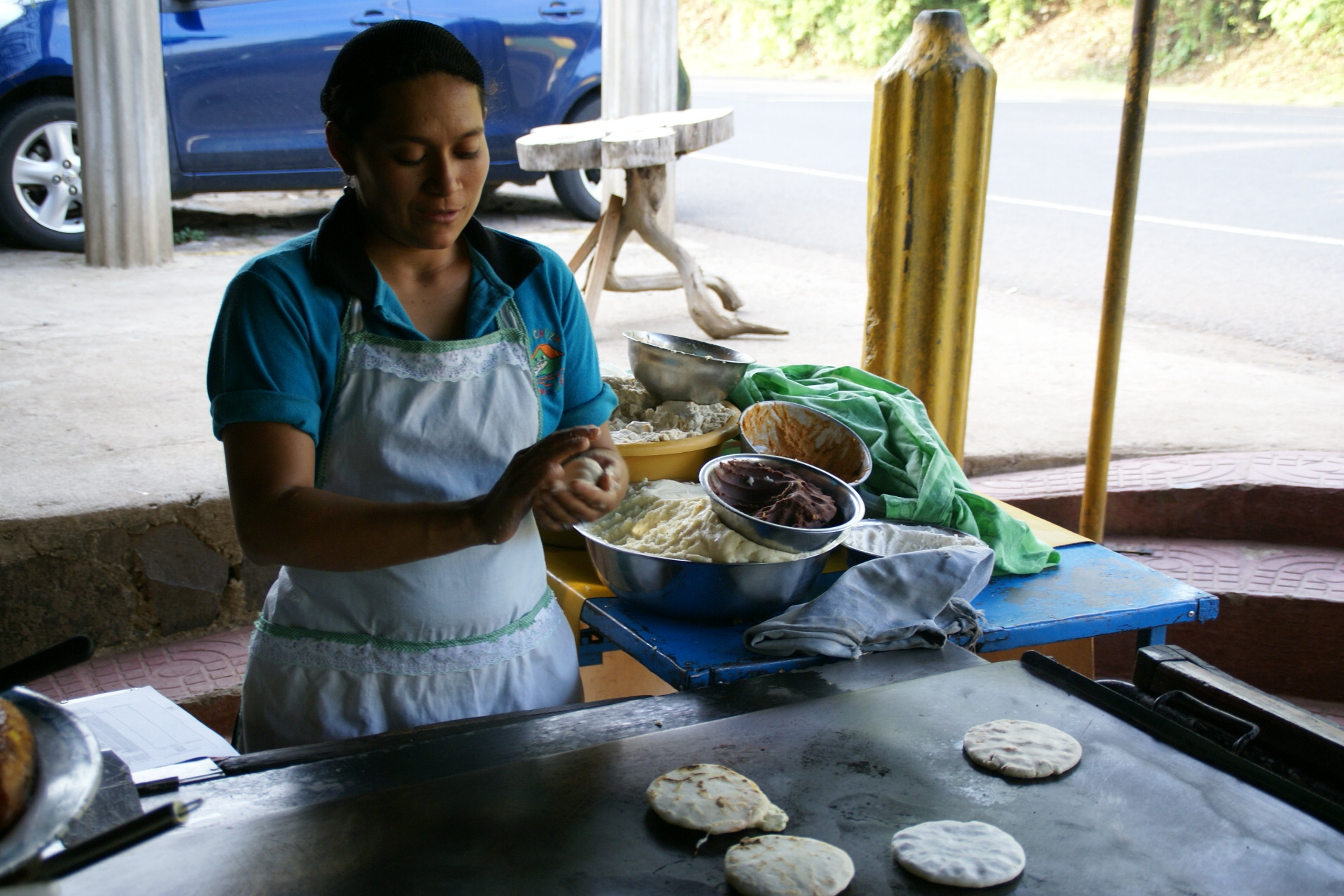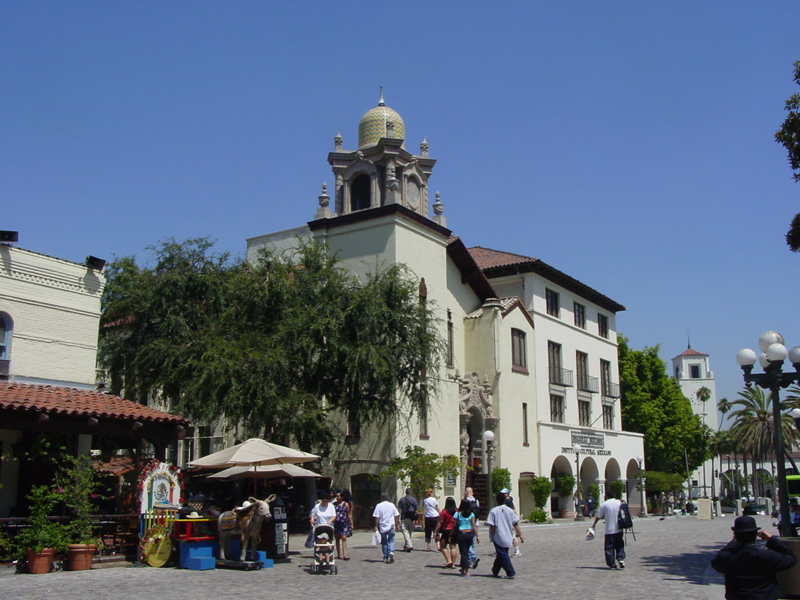|
Pupusa
A pupusa is a thick griddle cake or flatbread from El Salvador and Honduras, made with cornmeal or rice flour, similar to the Colombian and Venezuelan arepa. In El Salvador, it has been declared the national dish and has a specific day to celebrate it. It is usually stuffed with one or more ingredients, which may include cheese (such as ''quesillo'' or cheese with ''loroco'' buds), ''chicharrón'', squash, or refried beans. It is typically accompanied by ''curtido'' (a spicy fermented cabbage slaw) and tomato salsa, and is traditionally eaten by hand. Etymology There is no definite explanation for the origin of the word. The word for pupusa in one of El Salvador's native languages, Nawat, is . It is possible that the word stems from the verb ''pupusawa'' which means 'to puff up', but there is no known current or historical use of this word within the communities. Origin El Salvador and Honduras both claim to be the birthplace of the pupusa. Salvadoran archeologist Roberto ... [...More Info...] [...Related Items...] OR: [Wikipedia] [Google] [Baidu] |
El Salvador
El Salvador (; , meaning " The Saviour"), officially the Republic of El Salvador ( es, República de El Salvador), is a country in Central America. It is bordered on the northeast by Honduras, on the northwest by Guatemala, and on the south by the Pacific Ocean. El Salvador's capital and largest city is San Salvador. The country's population in 2022 is estimated to be 6.5 million. Among the Mesoamerican nations that historically controlled the region are the Lenca (after 600 AD), the Mayans, and then the Cuzcatlecs. Archaeological monuments also suggest an early Olmec presence around the first millennium BC. In the beginning of the 16th century, the Spanish Empire conquered the Central American territory, incorporating it into the Viceroyalty of New Spain ruled from Mexico City. However the Viceroyalty of Mexico had little to no influence in the daily affairs of the isthmus, which was colonized in 1524. In 1609, the area was declared the Captaincy General of Guatemala by t ... [...More Info...] [...Related Items...] OR: [Wikipedia] [Google] [Baidu] |
Salvadoran American
Salvadoran Americans ( or ) are Americans of full or partial Salvadoran descent. As of 2010, there are 2,195,477 Salvadoran Americans in the United States, the fourth-largest Hispanic community by nation of ancestry.US Census Bureau 2011 American Community Survey B03001 1-Year Estimates HISPANIC OR LATINO ORIGIN BY SPECIFIC ORIGIN Factfinder.census.gov, retrieved October 28, 2012 According to the Census Bureau, in 2016 Salvadorans made up 3.8% of the total Hispanic population in the US. Salvadorans are the largest group of Central Americans of the |
Curtido
Curtido () is a type of lightly fermented cabbage relish. It is typical in Salvadoran cuisine and that of other Central American countries, and is usually made with cabbage, onions, carrots, oregano, and sometimes lime juice; it resembles sauerkraut, ''kimchi'', or tart coleslaw. It is commonly served alongside ''pupusas'',Bain, Jennifer and Filson, Jon (September 18, 2002). "Pupusa festival leads to Venezuelan arepas". ''Torontohello Star''. the national delicacy. Fellow Central American country Belize has a similar recipe called "curtido" by its Spanish speakers; however, it is a spicy, fermented relish made with onions, habaneros, and vinegar. It is used to top salbutes, garnaches, and other common dishes in Belizean cuisine. Curtido, in this example, is made with onions, chillies and carrots. This is in a pupusería in Olocuilta, El Salvador See also * Encurtido Encurtido is a pickled appetizer, side dish and condiment in the Mesoamerican region. It consists of v ... [...More Info...] [...Related Items...] OR: [Wikipedia] [Google] [Baidu] |
Olocuilta
Olocuilta is a Municipalities of El Salvador, municipality in the La Paz Department, El Salvador, La Paz Departments of El Salvador, department of El Salvador, just a few kilometers down the highway from Santo Tomás. This town is well known for Pupusas de arroz, rice flour pupusas Since it is on the main highway which connects San Salvador with the airport and the other main highway, which goes along the shore, (carretera litoral), it is a popular spot for pupusas, and there are some pupuserias which are open 24 hours. Of course, in some of the pupuserias, it is possible to get them made with corn flour instead. References Municipalities of the La Paz Department (El Salvador) {{ElSalvador-geo-stub ... [...More Info...] [...Related Items...] OR: [Wikipedia] [Google] [Baidu] |
Arepa
''Arepa'' () is a type of food made of ground maize dough stuffed with a filling, eaten in the northern region of South America since pre-Columbian times, and notable primarily in the cuisine of Colombia and Venezuela, but also present in the cuisines of Bolivia, Panama and other countries. It is commonly eaten in those countries and can be served with accompaniments such as cheese, ''cuajada'' (fresh cheese), various meats, chicken, avocado, or ''diablito'' (deviled ham spread). It can also be split to make sandwiches. Sizes, maize types, and added ingredients vary its preparation. It is similar to the Mexican ''gordita,'' the Salvadoran ''pupusa'', the Ecuadorian ''tortilla de maíz'' and the Panamanian ''tortilla'' or ''changa''. Origins The ''arepa'' is a pre-Columbian dish from the area that is now Colombia, Panama and Venezuela. Instruments used to make flour for the ''arepas'', and the clay slabs on which they were cooked, were often found at archaeological sites in the a ... [...More Info...] [...Related Items...] OR: [Wikipedia] [Google] [Baidu] |
National Dish
A national dish is a culinary dish that is strongly associated with a particular country. A dish can be considered a national dish for a variety of reasons: * It is a staple food, made from a selection of locally available foodstuffs that can be prepared in a distinctive way, such as ''fruits de mer'', served along the west coast of France. * It contains a particular ingredient that is produced locally, such as the South American paprika grown in the European Pyrenees. * It is served as a festive culinary tradition that forms part of a cultural heritage—for example, barbecues at summer camp or fondue at dinner parties—or as part of a religious practice, such as Korban Pesach or Iftar celebrations. * It has been promoted as a national dish, by the country itself, such as the promotion of fondue as a national dish of Switzerland by the Swiss Cheese Union (Schweizerische Käseunion) in the 1930s. National dishes are part of a nation's identity and self-image. During t ... [...More Info...] [...Related Items...] OR: [Wikipedia] [Google] [Baidu] |
Masa
''Masa'' (or ''masa de maíz'') (; ) is a maize dough that comes from ground nixtamalization, nixtamalized corn. It is used for making corn tortillas, ''gorditas'', ''tamales'', ''pupusas'', and many other Latin American cuisine, Latin American dishes. It is dried and powdered into a maize flour, flour form called ''masa harina''. Masa is reconstituted from masa harina by mixing with water before use in cooking. In Spanish language, Spanish, ''masa harina'' translates to "dough flour", which can refer to many other types of dough. Preparation Field corn grain is dried and then treated by cooking the mature, hard grain in a diluted solution of slaked lime (calcium hydroxide) or wood ash, and then letting it soak for many hours. The soaked maize is then rinsed thoroughly to remove the unpalatable flavor of the alkali. This process is nixtamalization, and it produces hominy, which is ground into a relatively dry dough to create fresh masa. The fresh masa can be sold or used directl ... [...More Info...] [...Related Items...] OR: [Wikipedia] [Google] [Baidu] |
Fernaldia Pandurata
''Fernaldia pandurata'' (common name: loroco ) is a vine with edible flowers, widespread in El Salvador, Guatemala, and other countries in Central America.Morales, J.F. (2009). Estudios en las Apocynaceae neotropicales XXXIX: revisión de las Apocynoideae y Rauvolfioideae de Honduras. Anales del Jardin Botanico de Madrid 66: 217-262. ''Fernaldia pandurata'' is an important source of food in Guatemala and El Salvador. The plant's buds and flowers are used for cooking in a variety of ways, including in pupusas. The name "loroco" is used throughout Mesoamerica to refer to ''Fernaldia pandurata''.Azurdia, César; Loroco (''Fernaldia pandurata'', Apocynaceae), a Mesoamerican species in the process of domestication ''Fernaldia pandurata'' is an herbaceous vine with oblong-elliptical to broadly ovate leaves . long, 1.5–8 cm broad, inflorescences are generally somewhat shorter than the leaves, with 8–18 flowers, the pedicels 4–6 mm. long; bract In botany, a bract is ... [...More Info...] [...Related Items...] OR: [Wikipedia] [Google] [Baidu] |
Los Angeles
Los Angeles ( ; es, Los Ángeles, link=no , ), often referred to by its initials L.A., is the largest city in the state of California and the second most populous city in the United States after New York City, as well as one of the world's most populous megacities. Los Angeles is the commercial, financial, and cultural center of Southern California. With a population of roughly 3.9 million residents within the city limits , Los Angeles is known for its Mediterranean climate, ethnic and cultural diversity, being the home of the Hollywood film industry, and its sprawling metropolitan area. The city of Los Angeles lies in a basin in Southern California adjacent to the Pacific Ocean in the west and extending through the Santa Monica Mountains and north into the San Fernando Valley, with the city bordering the San Gabriel Valley to it's east. It covers about , and is the county seat of Los Angeles County, which is the most populous county in the United States with an estim ... [...More Info...] [...Related Items...] OR: [Wikipedia] [Google] [Baidu] |
Guinness World Records
''Guinness World Records'', known from its inception in 1955 until 1999 as ''The Guinness Book of Records'' and in previous United States editions as ''The Guinness Book of World Records'', is a reference book published annually, listing world records both of human achievements and the extremes of the natural world. The brainchild of Sir Hugh Beaver, the book was co-founded by twin brothers Norris and Ross McWhirter in Fleet Street, London, in August 1955. The first edition topped the best-seller list in the United Kingdom by Christmas 1955. The following year the book was launched internationally, and as of the 2022 edition, it is now in its 67th year of publication, published in 100 countries and 23 languages, and maintains over 53,000 records in its database. The international franchise has extended beyond print to include television series and museums. The popularity of the franchise has resulted in ''Guinness World Records'' becoming the primary international authority ... [...More Info...] [...Related Items...] OR: [Wikipedia] [Google] [Baidu] |
Disruptive Editing
Disruption, disruptive, or disrupted may refer to: Business *Creative disruption, disruption concept in a creative context, introduced in 1992 by TBWA's chairman Jean-Marie Dru *Disruptive innovation, Clayton Christensen's theory of industry disruption by new technology or products Psychology and sociology *Disruptive behavior disorders, a class of mental health disorders *Disruptive physician, a physician whose obnoxious behaviour upsets patients or other staff *Social disruption, a radical alteration, transformation, dysfunction or breakdown of social life Other uses *Cell disruption is a method or process in cell biology for releasing biological molecules from inside a cell *''Disrupted: My Misadventure in the Start Up Bubble'', a 2016 book by Daniel Lyons *Disruption (adoption) is also the term for the cancellation of an adoption of a child before it is legally completed *Disruption (of schema), in the field of computer genetic algorithms *Disruption of 1843, the divergence o ... [...More Info...] [...Related Items...] OR: [Wikipedia] [Google] [Baidu] |





.jpg)